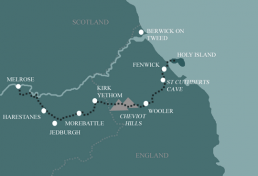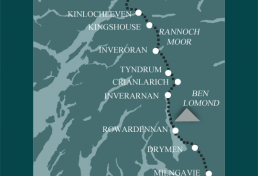Walking Holidays in Scotland
Scotland is a true walker’s paradise, with everything from gentle lowland trails and coastal paths to the rugged peaks of the Highlands. Whether you’re drawn to the quiet charm of the Borders or the wild drama of the Highlands, there’s something here for everyone. Our holidays showcase the best of Scotland - sweeping mountain landscapes, tranquil lochside views, glimpses into the country’s rich history, and even the chance to visit working distilleries or watch salmon leap upriver. Whatever your interests, we’ll help you find the Scottish walk that’s just right for you.
The Borders Abbeys Way is a 68 mile circular walk from Melrose, through the rolling countryside of the Scottish Borders. Following the Tweed and the Teviot, and passing flower-filled meadows rich with birdlife, this gentle route links the region’s historic ruined abbeys.
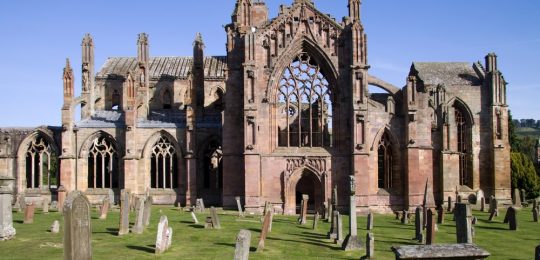
The Borders Abbeys Way links four of Britain’s most magnificent ruined medieval abbeys; Melrose, Dryburgh, Kelso and Jedburgh. The abbeys along with a host of historical sites paint a picture of the conflicts between the kingdoms of Scotland and England that raged throughout the Borderlands from the mid-12th to early 17th centuries.
Well waymarked and good under foot, the walking is a pleasure. The gradients are for the most part gentle, yet the views are at times breathtakingly beautiful. Riverside paths following the Tweed and the Teviot, old drove roads and disused railway lines along with forest tracks and open moorland combine to guide you on a spectacular 68 mile circuit of the Scottish Borders countryside that will delight even the most seasoned walker.
Founded in the first half of the 12th century on the command of King David I of Scotland the abbeys are testament to the supremacy and prosperity of medieval Anglo Norman monasticism. However, for four centuries the abbeys and the Borders folk fell victim to the lawlessness and violence that engulfed the region. Never more so than during Wars of Scottish Independence in the 14th century, when Scotland, led by Robert the Bruce emerged victorious with the re-establishment of an independent Scottish monarchy. The ruins that remain today are largely the result of military campaigns by the Earl of Hertford in 1544 and 1545 on behalf of King Henry VIII of England. Further destruction came from repeated vandalism by cross border militias known as Reivers and later Moss Troopers, during a period when the Borders was a perilous and lawless frontier.
Those days are past now and what remains is a place of peacefulness, a gentle countryside where historic towns and picturesque villages await you with a warm welcome. Nature lovers will rejoice in the Borders. The Tweed and the Teviot are home to salmon, trout and grayling. As you walk the river banks look for swans, tufted ducks and the great crested grebe. Nearby will be the grey wagtail and the sandmartin. Listen for the curlew, the skylark and from the hawthorn bushes, the song of the yellow hammer. In the meadows common spotted orchid can be found as well as mountain pansy, harebell, wood sorrel and primrose. Woodland gives cover to the redpoll, bullfinch and siskin while providing shelter for roe deer, badgers, fox and great spotted woodpeckers.
Length
5 - 8 nights
Full Route Length
68 miles / 109 km
Average Grade
Moderate
Why do this walk?
Marvel at four of Britain’s most magnificent ruined medieval abbeys.
Discover the story of the Border Reivers and Moss Troopers.
Explore the lands where King Robert the Bruce launched his raids into England.
Enjoy gentle riverside paths following the Tweed and the Teviot.
Visit Abbottsford House, the magnificent former residence of Sir Walter Scott.
Immerse yourself in the peace and tranquility of the spacious Borders farmlands.
The Fife Coastal Path is an 81 mile walk from North Queensferry on the Firth of Forth to Newport-on-Tay on the Firth of Tay, passing through the charming fishing villages of the East Neuk of Fife. With sweeping beaches, rugged cliffs, and rich maritime history, it offers a captivating coastal journey.

The Fife Coastal Path is a journey of discovery. Designated by Scottish Natural Heritage as one of Scotland’s Great Trails, this 81 mile route is an absolute joy every step of the way, stretching from the Forth Estuary in the south to the Tay Estuary in the north.
The path begins at North Queensferry with spectacular views of the estuary, the iconic Forth Bridges and the Edinburgh skyline. The walking is relatively straightforward, but the terrain is geologically fascinating, with evidence of lava flows and limestone strata containing marine fossils. Dysart Harbour and the Harbourmaster’s House are highlights as you make your way through the 7th century Royal Burgh. Cultural heritage, historic monuments, quaint villages, valued nature reserves, volcanic plugs and Fife’s only working fishing harbour are just some of the gems decorating the path as you continue to St Andrews, before reaching your journey’s end at Newport-on-Tay.
Clifftop trails, woodland paths, abandoned railway tracks, and grassy trails winding through golden sand dunes, combine to deliver an incredible walking experience as you travel through the Kingdom of Fife. Always charming, at times challenging, the Fife Coastal Path, along with the warm Scottish welcome of its hosts, will stay with you long after your journey ends.
Length
4 - 7 nights
Full Route Length
81 miles / 130 km
Shortest Break Length
34 miles / 55km
Average Grade
Easy to Moderate
Why do this walk?
Delight in 15 Seaside Award beaches and discover a host of charming coves.
Marvel at rock formations, lava flows and fossil sites dating back to a time of active volcanoes and tropical swamps.
View stunning examples of architecture spanning eight centuries.
Enjoy the many nature or wildlife reserves and sites of special scientific interest boasting marshlands, calcareous dunes and botanically important coastal grasslands.
Spot grey seals and bottlenose dolphins, bats and red squirrels.
Walk through historic fishing villages and bustling harbours, each with its own unique charm and maritime heritage.
The Great Glen Way is a 73 mile coast-to-coast walk from Fort William to Inverness, following the Caledonian Canal and the shores of Loch Ness. A gentler introduction to the Highlands, it offers a mix of forest trails, lochside paths, and dramatic mountain views.
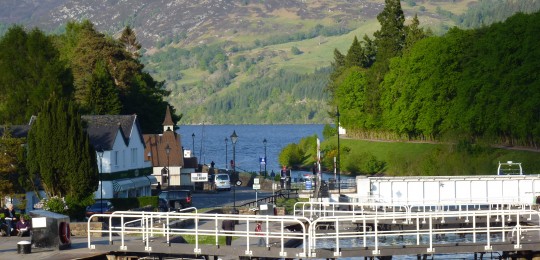
The Great Glen Way is a 73 mile coast to coast path from Fort William on the Atlantic west coast to Inverness on the North Sea. The trail follows the natural geological fault line running through the Great Glen, also known as Glen Albyn or Glen Mor.
The walk begins at Fort William, in the shadow of Britain’s highest mountain, Ben Nevis. From there the Great Glen Way waves goodbye to Loch Linnhe and heads north on the Caledonian Canal past Neptune’s Staircase and on to Gairlochy before journeying along the banks of Loch Lochy, Loch Oich and Loch Ness, famous for its mythical monster. The trail leaves Loch Ness as it winds through the ancient Abriachan woodland, home to pine martens, red squirrels and golden eagles, before joining the River Ness to reach Inverness Castle and the end of the trail.
With its good waymarking, this is a relatively easy and predominantly low level route along canal towpaths and enchanting forest tracks, providing great views of the lochs of the Great Glen and fine panoramas of the surrounding mountains. The castles and forts along the trail provide a glimpse into Scotland’s rich history and culture.
The Great Glen Way is the perfect introduction to long distance walking in the Scottish Highlands. From the towering Ben Nevis to the tranquil shores of Loch Ness, this trail immerses you in Scotland’s rich heritage and stunning landscapes. Whether you’re captivated by the beauty of the lochs, the wildlife of the ancient woodlands, or the fascinating history woven through castles and forts, the Great Glen Way promises a memorable and rewarding journey.
Length
6 - 8 nights
Full Route Length
73 miles / 117 km
Average Grade
Moderate
Why do this walk?
Walk coast to coast through the dramatic Great Glen, following an ancient geological fault line.
Enjoy stunning views of Scotland’s most famous lochs, including Loch Lochy, Loch Oich, and the legendary Loch Ness.
Follow the historic Caledonian Canal, passing Neptune’s Staircase, with its impressive series of lock gates.
Spot wildlife in ancient woodlands, from red squirrels and pine martens to soaring golden eagles.
Experience the majesty of Scotland’s mountains, with Ben Nevis standing tall at the start of the route.
Arrive in Inverness, the capital of the Highlands, with its historic castle marking the journey’s end.
The John Muir Way is a 135 mile coast-to-coast route from Helensburgh to Dunbar, birthplace of conservationist John Muir. Passing through Scotland’s central belt, it blends rich history, diverse landscapes, and coastal scenery.
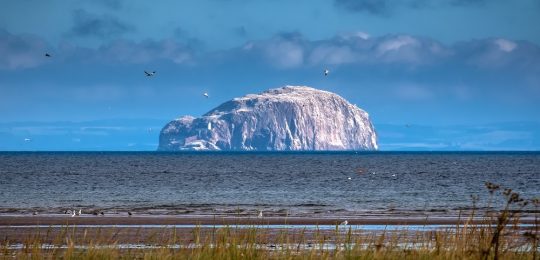
This delightful coast to coast trail through central Scotland delivers a perfect blend of country, coastal and leafy urban walking. One of Scotland’s Great Trails, the John Muir Way journeys for 135 miles from Helensburgh on the Firth of Clyde to Dunbar in East Lothian. Along the way you’ll enjoy stunning views over Loch Lomond, walk beneath the impressive Campsie Fells and explore remnants of Roman forts and the Antonine Wall. You’ll spend time in Scotland’s capital, view historic homes, and marvel at miles of sweeping golden sands. All this before entering the John Muir Country Park, a haven for nature lovers. Finally, take time to reflect on your achievement with an idyllic clifftop approach to Dunbar.
John Muir was a remarkable man; a botanist, geologist and glaciologist. He found fame as an author, explorer and environmental campaigner, and is best known to many as the father of the United States national parks. Born in Dunbar in 1838, he spent the first eleven years of his life there, finding enjoyment exploring the surrounding countryside and coastline, as well as scrambling on the ruins of Dunbar Castle. He later wrote “When I was a boy in Scotland I was fond of everything that was wild, and all my life I’ve been growing fonder and fonder of wild places and wild creatures.”
It’s fitting therefore that in addition to the sublime scenery, the John Muir Way features a variety of habitats, home to a wealth of flora and fauna. The trail’s hedgerows, often fragrant with flowers, give shelter to the likes of voles and weasels as well as goldfinches and wrens. In the skies above expect to see kestrels and buzzards. The John Muir Country Park covers an area of nearly 2000 acres and this saltmarsh, grassland and woodland supports over 400 plant species and a variety of birdlife including the skylark and ringed plover. The canals and lochs on the Way are home to swans and a variety of ducks. Coastal paths are adorned with thrift, wild thyme and common orchids. Cormorants and lapwings patrol the coast while a number of islands in the Firth of Forth house colonies of puffins and gannets, most notably the magnificent Bass Rock.
All those that follow this incredible trail through Scotland will find themselves immersed in nature, enriched by history, and rewarded with a renewed feeling of wellbeing.
Length
5 - 11 nights
Full Route Length
135 miles / 217 km
Shortest Break Length
57 miles / 92 km
Average Grade
Easy to Moderate
Why do this walk?
Walk coast to coast through Scotland on a picturesque low level trail.
Journey in the shadows of the impressive Campsie Fells and Kilsyth Hills.
Marvel at the incredible Falkirk Wheel and walk alongside the Union Canal.
Visit Linlithgow Palace, birthplace of Mary Queen of Scots.
Take the opportunity to scale the magnificent Arthur’s Seat enjoying panoramic views over Edinburgh.
Walk through the John Muir Country Park, home to over 400 plant species and variety of birdlife.
The Rob Roy Way is a 79 mile walk from Drymen to Pitlochry, through a rugged landscape steeped in the history of the legendary outlaw Rob Roy MacGregor. Following ancient drovers’ tracks, forest paths, and quiet lanes, it features stunning views of lochs, mountains, and glens.
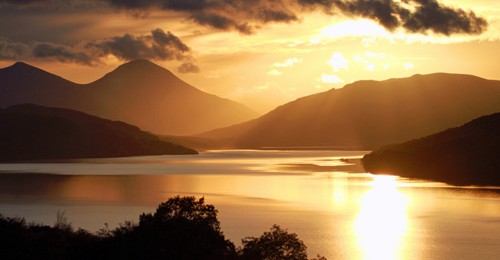
The Rob Roy Way encompasses many of the places linked with the now legendary Scottish outlaw and folk hero, Rob Roy MacGregor, who lived in the late 17th and early 18th centuries. The 79 mile trail begins in Drymen, on the southeastern edge of the Loch Lomond & The Trossachs National Park, and journeys north through the picturesque landscapes of Stirlingshire and Perthshire, finishing in the vibrant town of Pitlochry.
Embarking on the Rob Roy Way, walkers are immersed in the tranquil woodlands of the Queen Elizabeth Forest Park, where the richness of Scotland’s flora and fauna immediately becomes apparent. As you thread your way through the wild expanse of the Trossachs, a rugged beauty unfolds, reminiscent of the untamed nature that once provided cover for Rob Roy’s daring endeavours. The splendour of the trail continues with the dramatic landscapes surrounding Loch Tay.
In addition to the stunning wilderness, the route passes through charming villages and historic sites, including the atmospheric ruins of the 16th-century Balquhidder Kirk, where Rob Roy MacGregor is laid to rest.
Celebrated for its blend of natural beauty and historical resonance, the Rob Roy Way invites adventurers to walk in the footsteps of a legend. Each step weaving together a narrative of rugged landscapes, serene lochs, and the indomitable spirit of the Scottish Highlands.
Length
6 - 8 nights
Full Route Length
79 miles / 126 km
Shortest Break Length
69 miles / 111 km
Average Grade
Moderate
Why do this walk?
Walk in the footsteps of the legendary Scottish outlaw, Rob Roy MacGregor, through the scenic landscapes of the Trossachs.
Experience the tranquil beauty of the Queen Elizabeth Forest Park, rich with wildlife and stunning flora.
Discover the tranquil shores of Loch Tay, surrounded by towering mountains.
Visit the historic Balquhidder Kirk, the final resting place of Rob Roy MacGregor.
Wander through charming villages that reflect the traditional Scottish Highlands way of life.
Visit picturesque Callandar and the renowned Victorian town of Pitlochry.
The Speyside Way is a 92 mile walk from Buckie on the Moray coast to Aviemore in the foothills of the Cairngorms. Passing through Scotland’s famous whisky country, this route follows woodland trails, riverside paths and old railway lines, offering a scenic and gentle journey with stunning mountain views.
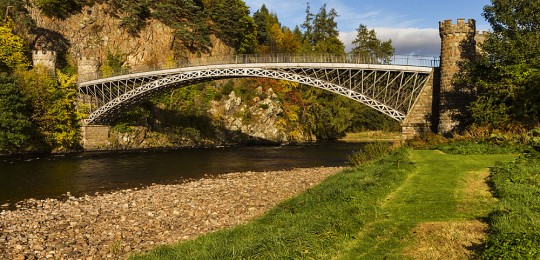
Weaving through the heart of Scotland’s whisky country, the Speyside Way stands as a testament to the country’s stunning landscapes and rich heritage. As a result it has established itself as one of Scotland’s most popular trails. The 65 mile journey commences in the vibrant town of Buckie on the Moray Firth, and winds its way southward, culminating in the historic village of Aviemore, nestled within the Cairngorms National Park. Walkers seeking further exploration and a longer experience can choose to incorporate the Tomintoul and Dufftown spurs into their holiday.
Your introduction to the Speyside Way is the crisp sea air of the Moray Firth. As you venture on, the trail unveils the picturesque Spey Valley, famed for its meandering river and fertile landscapes. The route guides you through charming whisky villages such as Craigellachie and Aberlour, where historic distilleries dot the landscape, inviting you to explore the craftsmanship behind Scotland’s beloved spirit.
The Speyside Way then leads you into the heart of the Cairngorms, offering a dramatic change in scenery. The trail takes you through ancient pine forests and over open moorlands, with majestic views of the Cairngorm Mountains as your backdrop.
Ultimately, the Speyside Way is much more than a walking trail – it’s an exploration of Scotland’s diverse landscapes, captivating history, and the artistry of its famed distilleries. Whether tracing the banks of the River Spey, strolling through woodlands, or savouring the warmth of Scottish hospitality, the Speyside Way promises to be a memorable adventure for those seeking the essence of Scotland’s cultural and natural treasures.
Length
6 - 8 nights
Full Route Length
92 miles / 148 km
Shortest Break Length
65 miles / 105 km
Average Grade
Moderate to Challenging
Why do this walk?
Enjoy the crisp sea air of the Moray Firth as you begin your journey.
Discover the artistry of Scotland’s whisky-making heritage at renowned distilleries in Craigellachie and Aberlour.
Enjoy stunning views of the River Spey, with its fertile valleys and picturesque surroundings.
Experience the tranquillity of ancient pine forests and open moorlands, with breathtaking views of the Cairngorm Mountains.
Enjoy the peace and tranquillity of one of Scotland's quieter corners.
End your adventure in the historic village of Aviemore, nestled in the heart of the Cairngorms National Park.
St Cuthbert’s Way is a 63 mile walk from Melrose in the Scottish Borders to the Holy Island of Lindisfarne in Northumberland. Passing through peaceful countryside and historic sites, it follows in the footsteps of the 7th-century saint.
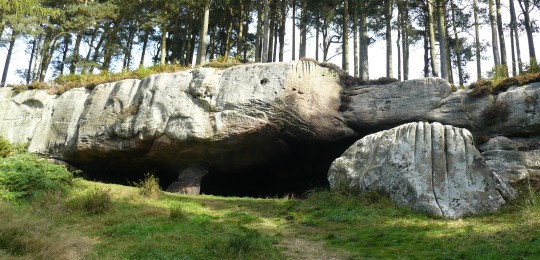
St Cuthbert’s Way threads its way through the quiet countryside of the Scottish Borders and Northumberland, linking key locations associated with the 7th Century Saint. The trail begins in the market town of Melrose in the Scottish Borders and finishes on the Holy Island of Lindisfarne on the edge of the North Sea. Along the way it takes in some beautiful countryside, including the banks of the River Tweed and the foothills of the Cheviot Hills, and visits significant historical sites such as Dryburgh Abbey and St Cuthbert’s Cave.
Starting in Melrose you will head through the Eildon Hills with great views of the surrounding countryside, before following the banks of the famous River Tweed. After a quick detour to explore the ruins of Dryburgh Abbey, you follow the course of Dere Street, an ancient Roman Road, before heading cross-country to Kirk Yetholm, the northern terminus of the Pennine Way.
Next, you’ll venture through the foothills of the remote and beautiful Cheviot Hills, and on to the peaceful market town of Wooler. As you near the coast, you will visit St Cuthbert’s Cave, a site of great spiritual significance, before descending to the unique tidal causeway that leads to Holy Island with its spectacular priory and castle.
Whether you’re seeking a journey through history, breathtaking landscapes, or a quiet spiritual retreat, St Cuthbert’s Way offers a truly enriching walking experience.
Length
5 - 8 nights
Full Route Length
63 miles / 101 km
Average Grade
Moderate
Why do this walk?
Follow a route steeped in history and spirituality through the Scottish Borders and Northumberland.
Experience the beauty of rolling hills, meandering rivers, and peaceful woodlands.
Visit ancient sites like St Cuthbert's Cave, Dryburgh Abbey, and the historic town of Melrose.
Follow the ancient Roman road of Dere Street, connecting you to centuries of history.
Cross the tidal causeway to the Holy Island of Lindisfarne, a memorable end to the trip.
Visit Lindisfarne Priory and Castle, iconic sites steeped in history.
The West Highland Way is a 95 mile route from Milngavie, near Glasgow to Fort William, at the foot of Ben Nevis. Scotland’s most famous long-distance trail, it winds along the shores of Loch Lomond, and into the heart of the West Highlands.
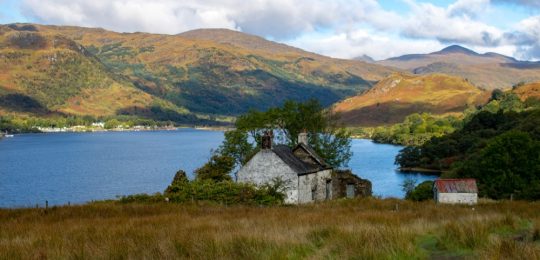
The West Highland Way was the first long distance footpath to be established in Scotland and has earned its place as one of country’s most iconic routes. The trail begins in Milngavie near Glasgow, and unfolds over 95 miles against the breathtaking backdrop of Scotland’s rugged landscapes, finishing in Fort William, in the shadow of Ben Nevis, Britain’s highest mountain.
From the off, the West Highland Way guides you through tranquil lowland plains and ancient woodlands as it makes its way onto Conic Hill where you are rewarded with stunning views over Loch Lomond, the largest body of fresh water in Britain. The line of small islands along the loch marks the direction of the Highland Boundary Fault and the start of the Scottish Highlands.
Venturing onward, the West Highland Way propels you into the heart of Rannoch Moor, a vast and wild expanse whose beauty lies in its untamed nature. All eyes are drawn to the magnificent Buachaille Etive Mòr, one of the most recognisable mountains in Scotland. Ascending the impressive Devil’s Staircase, you skirt the edge of the iconic Aonach Eagach Ridge, gaining fine views of Glen Coe, and on a clear day, Ben Nevis and the Mamore mountains.
Continuing its grand narrative, the trail descends into the peaceful town of Kinlochleven, before a delightful final stretch through the picturesque Glen Nevis to Fort William.
Celebrated for its challenging terrain and unparalleled beauty, the West Highland Way beckons adventurers from around the world. This remarkable route has become a pilgrimage for those seeking the very essence of Scotland’s wilderness.
Length
4 - 10 nights
Full Route Length
95 miles / 152 km
Shortest Break Length
46 miles / 74 km
Average Grade
Moderate to Challenging
Why do this walk?
Walk from the Lowlands into the Highlands on Scotland’s most iconic long-distance trail.
Enjoy stunning views over Loch Lomond from Conic Hill.
Experience the untamed wilderness of Rannoch Moor.
Marvel at Buachaille Etive Mòr, one of Scotland’s most iconic mountains.
Climb the Devil’s Staircase, with incredible views of Glen Coe and the Mamore mountains.
Complete your journey in Fort William, watched over by the magnificent Ben Nevis.






